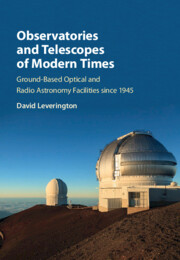 Observatories and Telescopes of Modern Times
Observatories and Telescopes of Modern Times from Part 2 - Radio Observatories
Published online by Cambridge University Press: 15 December 2016
Early Australian Radio Astronomy
Solar Observations
The Australian Radiophysics Laboratory was created at Sydney in 1939 as a secret branch of the Council for Scientific and Industrial Research (CSIR). It was to undertake radar research and development during the Second World War in collaboration with British laboratories and the Australian military.(1) The laboratory was highly successful, but as the war was coming to an end in 1945 the Australian government began to consider how its role should be changed. To assist in the decision Edward G. (Taffy) Bowen, who was soon to take over as the head of the reconstituted Radiophysics Laboratory, assembled a series of papers for a meeting of the CSIR Council in July of that year. These resulted in a decision to concentrate future research in three areas, namely radio, vacuum, and rain and cloud physics. Bowen was to lead the rain and cloud physics group whilst Joe Pawsey, who had studied under John Ratcliffe at Cambridge in the 1930s, led the radio group. In October 1945, the radio group began to study the effect of the Sun on radio communications. This followed receipt of a report that a New Zealand military radar station on Norfolk Island had detected noise at 200 MHz (wavelength λ 1.5 m) that appeared to be connected with the Sun.
To study the Sun, Pawsey, Ruby Payne-Scott and Lindsay McCready initially used a Royal Australian Air Force wartime radar antenna on the coast at Collaroy 400 ft (120 m) above the sea near Sydney. It consisted of 40 half-wave dipoles operating at 200 MHz. After only three weeks of data they concluded that there was a close correlation between the total area of the Sun covered by sunspots and the magnitude of the radio noise which had varied by a factor of 30. Unfortunately the antenna could not be used to track the source in altitude but measurements of the noise along the horizon at sunrise and sunset clearly showed that it was associated with the Sun.(2)
To save this book to your Kindle, first ensure [email protected] is added to your Approved Personal Document E-mail List under your Personal Document Settings on the Manage Your Content and Devices page of your Amazon account. Then enter the ‘name’ part of your Kindle email address below. Find out more about saving to your Kindle.
Note you can select to save to either the @free.kindle.com or @kindle.com variations. ‘@free.kindle.com’ emails are free but can only be saved to your device when it is connected to wi-fi. ‘@kindle.com’ emails can be delivered even when you are not connected to wi-fi, but note that service fees apply.
Find out more about the Kindle Personal Document Service.
To save content items to your account, please confirm that you agree to abide by our usage policies. If this is the first time you use this feature, you will be asked to authorise Cambridge Core to connect with your account. Find out more about saving content to Dropbox.
To save content items to your account, please confirm that you agree to abide by our usage policies. If this is the first time you use this feature, you will be asked to authorise Cambridge Core to connect with your account. Find out more about saving content to Google Drive.